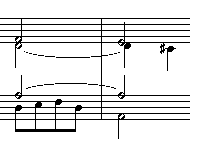
Go to Counterpointer information 
Entering multiple voices on the same staff
For counterpoint study it's best just to write a single melody on the staff, but it is possible to write additional voices on the same staff if you are in the free practice window (for exercises the multitrack feature is turned off, to avoid confusion.) In free practice mode each Counterpointer staff can carry as many as 8 separate melodic tracks or voices, though it would be rare to find music with more than 4 parts per staff.
The basic principle in multipart writing is that one of the voices defines the time of each measure - one voice's notes and rests must take up the entire value of the measure. We call that voice the primary track or "track one." Additional tracks can then be freely added without any requirement that their time fill the whole measure (this is the typical case, though in strict polyphonic writing it's musically desirable to make each voice complete in itself).
To add additional tracks to an existing passage just choose the desired note values, as you did before, and click in the music where you want them to go.
It's best to think as you do this about consistency of voices. If you're adding a second track, for example, it will generally work better musically if the notes of that track are not too far apart in pitch; it's good to let the notes of each track seem to follow each other naturally.

Short cuts
If you are entering notes by step entry (choosing rhythmic values and then playing the notes on the keyboard) Counterpointer will enter on the same stem any notes that are played at the same time (or even approximately the same time). So if your multiple parts are very simple you can enter them just by playing the notes:

Combining staves
If your writing involves complex inner voices you may find that it slows you down to manually enter each of several tracks on a staff, since only the first one can be quickly placed by clicking notes on the piano. If each part makes a complete melody, as for example in a 4-part chorale, you'll find it much quicker to enter each voice in a separate staff at first, then use the Merge Staves command (Staff Menu) to combine two or more melodies into one staff. Of course this can only work if each part is a complete melody.
For choral music you may find it desireable in any case to leave the parts on separate staves - perhaps only combining them to make a keyboard reduction. If the parts are on separate staves they take up more room, but are much easier for singers to read.